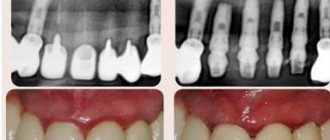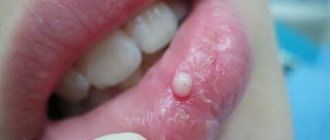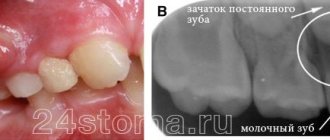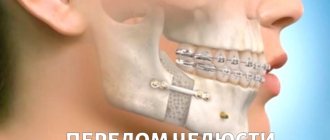A lump appeared on the gum: what could be the reason?
A lump on the gum, by and large, is a compaction that is caused by damage to periodontal tissue in a certain area. The cause of the lesion is another point on which the treatment plan and possible complications in the absence of timely medical care depend. First of all, the doctor determines the nature of the appearance of the lump on the gum, which comes in two types.
- Infectious nature.
Infection caused by pathogenic bacteria is the most common cause of lumps and lumps in the gum area. - Non-infectious nature.
This includes injuries, mechanical, chemical damage, as well as other factors not related to the activity of microorganisms.
A lump on the gum above a tooth or under a tooth (in the case of the lower jaw) appears much more often as a result of infections, however, the treatment regimen is individual for each case, depends on the specific symptoms and is drawn up after collecting an anamnesis. Next, it makes sense to describe in more detail the diseases and pathologies that provoke the appearance of seals on the gums.
Causes
Typically, a fistula is caused by poor oral hygiene. Plaque settles on the gums and teeth, which promotes the development of various bacteria. The latter can cause caries, as well as many other diseases. This also includes the purulent lump that forms on the gum. They are more common on the upper gum.
A lump with pus inside may indicate chronic periodontitis. It can appear and disappear, and its sizes vary. At the same time, a person’s teeth constantly hurt, his gums bleed, and his teeth begin to move. If you notice these symptoms, go to the dentist immediately.
As for the origin of the fistula, it should be divided:
- Infectious. Bacteria multiply here and release toxic substances;
- Non-infectious. When a person injured his gums or took strong medications.
There is an acute or chronic lump on the gum. In the case of an acute form, treatment is quick and easy. But the chronic form of the fistula requires surgical intervention.
Sometimes the patient says that after prosthetics, a lump appeared on the gum and pain appeared. This happens if during prosthetics the tooth surface was not treated very well or poor quality materials were used. Then a soft lump appears, which may hurt from time to time.
The pain of the lump may also indicate gumboil. Then you should visit the dentist immediately. After all, the pus that has accumulated inside the gums must be removed so that it does not provoke blood poisoning.
It is very important to detect the disease in time and begin proper gum treatment. If this is done at an early stage, you will not have to resort to surgery and tooth extraction.
Infectious diseases that can cause a lump on the gum
- Periostitis (flux).
Periostitis, or flux, usually occurs against the background of complications of caries, pulpitis and periodontitis, when infection and pus extend beyond the periodontal tissues and penetrate into the soft tissue area. You can notice with the naked eye that there is a swollen lump on the gum. - Complications of periodontitis (granuloma, cyst).
When infections occur at the root apex, a periodontal abscess occurs. Gradually, pus penetrates into the periosteum area, and then directly under the mucous membrane. Thanks to its elasticity, the patient often does not feel any unpleasant symptoms from the lump that appears, so he is in no hurry to see a doctor. Quite dangerous are cases when the pathology takes the form of a fistula, which looks like a small white lump near the tooth. The fistulous tract allows pus to come out, but this does not mean that the inflammatory process will disappear on its own; - Gingivitis and periodontitis.
With periodontal inflammation, swelling and hardening of the gums are almost always observed. Gingivitis is considered the initial stage of the disease, therefore it is characterized by the so-called red ball (gum tumor), while with periodontitis, purulent discharge is observed, and the tumor acquires a beige or grayish tint. In some particularly advanced cases, against the background of periodontal problems, gumboil may appear, which visually looks much more noticeable.
Reasons for the formation of an abscess
Young children do not properly care for their oral cavity. Poor brushing of teeth promotes the accumulation and proliferation of bacteria. Penetrating into the tissue, they provoke the development of inflammatory processes, including a purulent lump.
Other factors also influence the formation of an abscess:
- New teeth.
In some babies, the eruption of baby teeth is preceded by the appearance of small tumors filled with white fluid. If such a lump on the child’s gum does not hurt, then there is no reason to urgently consult a doctor.
- Gum injury.
Damage occurs due to the active lifestyle of babies, solid foods or accidental biting. The injured area becomes red and inflamed. Usually everything goes away on its own, but sometimes, when an infection occurs, ulcers and lumps appear.
- Oral diseases:
- caries;
- pulpitis;
- periostitis;
- cyst;
- fistula;
- gingivitis;
- periodontitis.
Inflammatory processes on the gums are often accompanied by abscesses. Purulent complications can be avoided by promptly consulting a doctor.
Non-infectious diseases that can cause a lump on the gum
- Epulis.
A small growth that has some kind of stalk, which occurs mainly due to injuries, malocclusions, improper prosthetics, during teething (in children), and also due to hormonal disorders (less often). In appearance, epulis may resemble a tumor due to gingivitis, so diagnosing the disease may require x-rays and histological examination. - Ecostosis.
This pathology is a bone growth that is formed due to a jaw anomaly. The main cause of ecostosis is considered to be a genetic predisposition, but pathology can develop after injuries and traumatic tooth extraction. In this case, the bone extends beyond its usual boundaries, resulting in the formation of a noticeable lump. The disease is not accompanied by an inflammatory process, but it can occur due to mechanical damage to the growth. - Hematoma.
It is formed as a result of a strong blow and may well go away on its own or with the use of special means. If the tissue structure is disrupted as a result of injury, the help of a surgeon is needed.
It hurts/doesn’t hurt: in what cases does pain occur?
Periostitis is considered the most painful. With this complication, the main inflammatory process is localized in the area of the bone and periosteum, which causes severe pain. Seals caused by the inflammatory process in the periodontium (gingivitis, periodontitis) are disturbing when pressed, thermal and mechanical influences are applied. Epulis and ecostosis, as a rule, are not accompanied by pain, but when damaged and inflamed, they also disturb the patient.
A lump near a tooth with periodontitis may not cause noticeable pain, especially if it has a fistulous tract. It is important to understand that the absence of pain does not mean that treatment can not be carried out. In most situations, the tooth can be saved, but some patients are very negligent about their health and consult a doctor in extreme cases. A lump above (or under) a tooth is quite an alarming signal, which often indicates the development of quite serious diseases.
Symptoms of an abscess
The initial stage of the formation of a white bump on the gum may be asymptomatic. The abscess gradually increases, leading to the following symptoms:
- formation of a painful protrusion;
- smell from the mouth;
- bleeding from gums;
- pain when eating.
If you do not help the child at this stage, further development of inflammation will lead to intoxication. The baby's temperature will rise and signs of weakness and malaise will appear.
Lump after crown installation
Improper denture fitting is a very common cause of lumps on the gums. Most often, errors occur at the tooth preparation stage, when the depulpation procedure is carried out. Poor canal filling provokes the development of infection, which, in turn, leads to periodontitis. Another common reason is a poorly made prosthesis or defects during its installation. In this case, the prosthesis injures the mucous membrane and causes swelling, abscesses and growths. Treatment almost always involves removal of the prosthesis and subsequent replacement of the prosthesis (if possible). The sooner a complication is detected, the higher the chance that it can be successfully treated. A well-installed prosthesis should not cause pain, discomfort or injure the mucous membrane. The tooth under the crown should also not hurt, since the dental nerve is killed before permanent prosthetics.
Treatment of cones and fistulas on the gums
Depending on the root cause and the condition of the formation, the dentist prescribes therapy. Which comes down to stopping the inflammatory process and preventing similar manifestations in the future. The dentist also treats the underlying disease, which is the main cause of painful inflammation and suppuration. Treatment of a fistula often comes down to the use of absorbable agents: under the influence of medicinal rinses, medications and medicinal ointments, the suppuration resolves and the swelling goes away. And it happens that to get rid of inflammation it will be enough to maintain oral hygiene. Treatment of lumps on the gums with periodontitis, periodontitis and epulis involves opening the swelling and cleaning the purulent contents. In any case, only a dentist can prescribe a treatment regimen and medications, having fully assessed the picture of the disease.
Treatment of lumps on the gum
The treatment plan depends entirely on the results of the diagnosis, which is designed to determine the root cause of the lump or ball on the gum, which is why the patient should not self-medicate, but go to the doctor as soon as possible. If the cause of the lump is an infection, then you need to eliminate the cause of its appearance. For complications of pulpitis and periodontitis, treatment can take a long time. The lump is opened, a drainage is installed to pump out the pus, after which the doctor prescribes conservative or surgical treatment to the patient, depending on the severity of the disease. In case of periodontal inflammation, professional cleaning and sanitation of the oral cavity are carried out, special ointments and antiseptics are prescribed. In more complex cases, curettage, physiotherapy, and so on are used. With epulis and ecostosis, pain and inflammation are often absent, so the decision about intervention is made together with the patient. Most often, the pathology will be removed after surgery: even a small bump on the gum (especially in the smile area) spoils the aesthetics, so it is understandable that a person wants to get rid of it.
The reason for the formation of a lump on the gum
There are two groups of reasons that lead to the appearance of a hard white lump on the gum. This formation itself is a tubercle, which may consist of inflamed tissue or be filled with pus. The tubercle may hurt constantly or when you press on it. Often it does not hurt at all and is not noticed immediately. Such a lump indicates one of many diagnoses. But let's return to the reasons.
The first group is infectious causes. Like most oral diseases, a hard lump on the gum is caused by poor hygiene. The problem is caused by irregular and poor-quality teeth cleaning, as well as tartar and gum inflammation left without treatment. Tooth decay can also cause a lump to appear. The spread of caries into the root canals will cause deep damage to the internal structures of the jaw.
The second group is injuries. For example, a complex tooth extraction may have been carried out inattentively. This often injures the gums. Also, pieces of tooth could remain in the jaw. Errors during implantation are another reason for the formation of a lump on the gum. Any incorrectly completed dental treatment is very dangerous, as consequences will certainly appear over time.
Even braces can cause a bump. It is also possible that the patient may have genetic disorders that could lead to the appearance of a lump on the gum on the inside or on the outside. Such a lump can also be a benign or malignant tumor. As you can see, there are many reasons - so it is necessary to undergo an inspection as soon as possible, because the consequences of all these violations will be quite serious.











